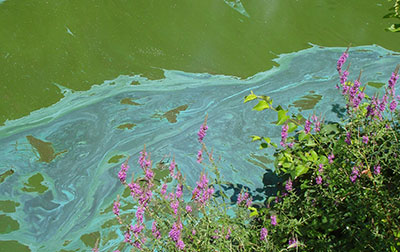
October 08, 2021| Environment
By: Holly Odgers
We have recently been receiving calls and seeing social media posts of people noticing some near-shore algal blooms at Lake Hopatcong that may be Harmful Algal Blooms (HABs). Algae blooms can be common throughout the fall. While these blooms may or may not be harmful or toxic, caution is recommended. Do not touch the water or allow children or pets to play in or drink the water.
As described by the National Environmental Education Foundation, “Once fall sets in, the surface water cools, becomes denser, and sinks to the bottom, finally allowing for mixing in the water column. The water that was previously at the bottom is buoyed up, bringing with it the supply of nutrients that accumulated on the lake floor through the summer. This large supply of phosphorous, nitrogen, and organic matter can stimulate a late bloom of algae at the surface, creating a green, brown, or red lake well into autumn.”
Dr. Fred Lubnow, Princeton Hydro’s Director of Aquatics Programs explains, “Over the last 10 years, and in particular, before the 2019 early summer HAB event on the lake, cyanobacteria HABs have routinely occurred at Lake Hopatcong over the fall / early winter seasons. However, as temperatures decline and the lake completely mixes, the cyanobacteria will eventually be replaced by algal groups that prefer cooler water temperatures. These algae, such as diatoms and chrysophytes, can give the water a brownish or turbid color. Thus, while small, isolated, near-shore HABs may be observed at Lake Hopatcong, they will eventually be replaced by more desirable algae that form the base of the lake's food web.”
Marty Kane, Lake Hopatcong Historical Museum President points out, "This is actually not a new phenomenon. There are reports going back up to one hundred years ago where people described the lake as "purging" or "turning over" in the fall when reporting seeing areas of algae or the lake change colors."
As noted in this New Jersey Department of Environmental Protection (NJDEP) report, "A cyanobacterial HAB often looks like a layer of bright bluish‐green or white paint on the water surface. Other evidence of a potential cyanobacterial HAB could be discolored or pea-green-colored water, parallel streaks, or green dots/globs in the water. It is important to note that some blooms are due to common green algae and not cyanobacteria. Additionally, even when present, cyanobacteria do not always produce cyanotoxins."
If you observe what you think might be a HAB, report it through NJDEP's HAB reporting form. Information on reported HABs can be viewed on NJDEP’s Interactive Map Reporting and Communication System. These links and more information about HABs can be found HERE.